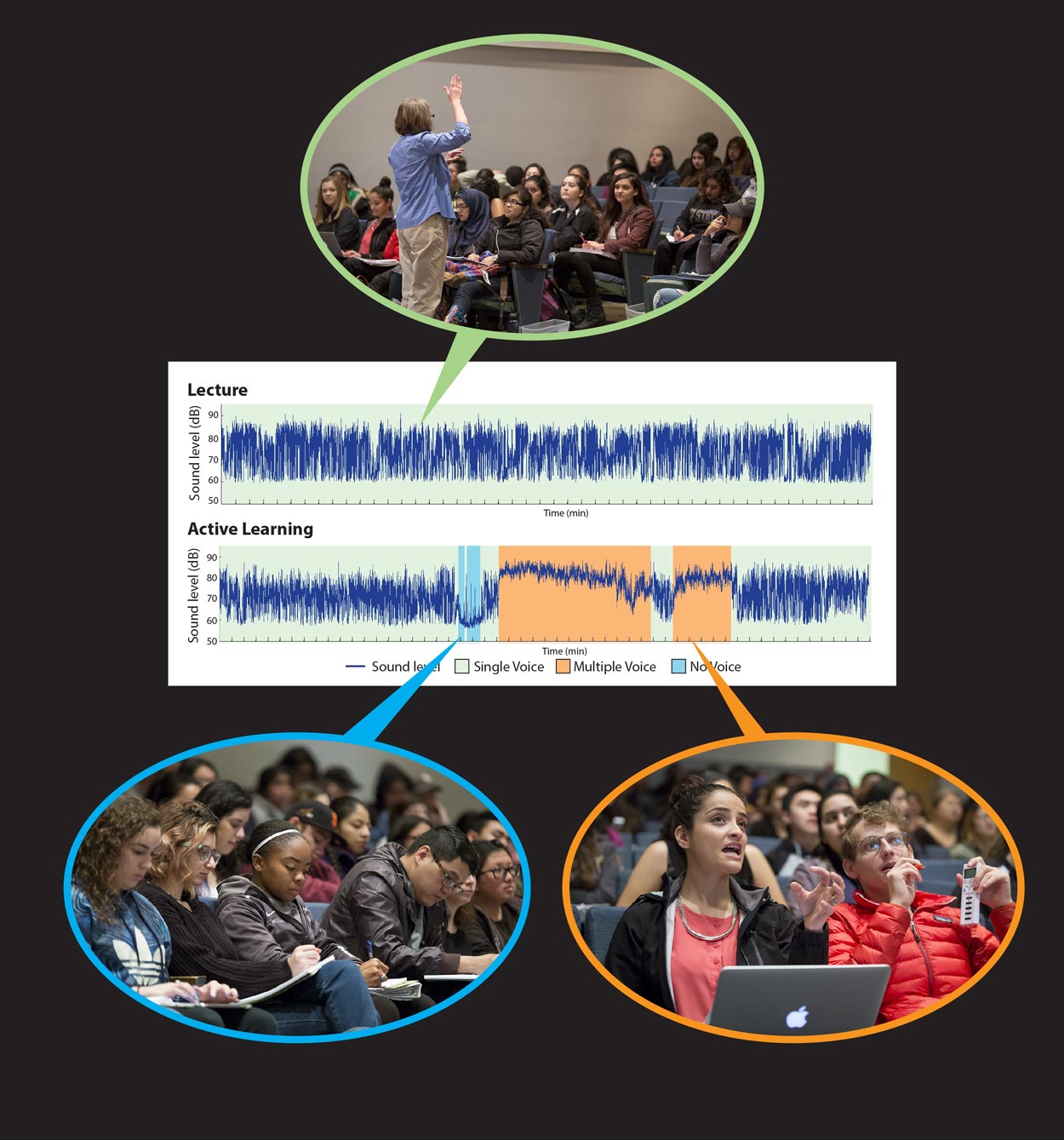Melinda Owens
Research
It is critically important to teach undergraduates about biology more effectively and to retain more of them in scientific and health careers. My lab addresses this issue by examining two broad questions: How do college instructors teach? How do college students think about biology?
How Do Instructors Teach?
Prior research shows that certain teaching strategies are more likely to promote engagement, retention, and learning among diverse students, but it has been difficult to examine the strategies instructors use on a large scale. Therefore, in collaboration with San Francisco State, we developed DART (Decibel Analysis for Research in Teaching). DART (dart.sfsu.edu) is a software tool that can quickly analyze classroom audio recordings to estimate with ~90% accuracy the time spent using certain teaching activities. We use DART to investigate a variety of questions, with the goals of better understanding how instructors teach and promoting evidence-based teaching practices.

DART uses classroom sound levels (dark blue line) to estimate the extent of "active learning" by classifying class time into these categories: Single Voice (e.g. lecture), Multiple Voice (e.g. pair and group discussions), and No Voice (e.g. student thinking or writing).
Owens et al. 2017
How Do Students Think?
Students learn more effectively when instructors know what ideas their students already have. In particular, previous studies reveal that students often harbor misconceptions that inhibit their ability to develop biological expertise. Many misconceptions are rooted in ways of intuitive thinking that predate modern scientific thought.
We are particularly interested in how undergraduate students understand and reason about health topics, such as vaccines. We ask undergraduates about their ideas about specific topics and examine their misconceptions and the types of reasoning they use. We will use our results to design education interventions to promote better learning about these topics.
Select Publications
Research in Biology Education
- S. Shahoy, M. Du, O. Mostafa, A. Parker, D. Martirano, M.T. Owens. 2024. Undergraduate level biology students’ application of central dogma to understand COVID mRNA vaccines. Journal of Microbiology and Biology Education. 0:e00167-23.
- Kahlon, G., Waheed, F., & Owens, M. T. (2022). What College Biology Students Know about How Vaccines Work. CBE life sciences education, 21(4), ar75.https://doi.org/10.1187/cbe.20-12-0294
- Zuckerman, A. L., Hardesty, R. A., Denaro, K., Lo, S. M., & Owens, M. T. (2021). Effects of Remote Teaching in a Crisis on Equity Gaps and the Constructivist Learning an Environment in an Introductory Biology Course Series. Journal of microbiology & biology education, 22(1), 22.1.70. https://doi.org/10.1128/jmbe.v22i1.2293
- M.T. Owens, G. Trujillo, S.B. Seidel, C.D. Harrison, K.M. Farrar, H.P. Benton, J.R. Blair, K.E. Boyer, J. Breckler, L.W. Burrus, D.T. Byrd, N. Caporale, E.J. Carpenter, Y.-H.M. Chan, J. Chen, L. Chen, L.H. Chen, D.S. Chu, W.P. Cochlan, R.J. Crook, K.D. Crow, J.R. de la Torre, W.F. Denetclaw, L.M. Dowdy, D. Franklin, M. Fuse, M.A. Goldman, B. Govindan, M. Green, H.E. Harris, Z.-H. He, S. Ingalls, P.D. Ingmire, A.R.B. Johnson, J.D. Knight, G. LeBuhn, T.L. Light, C. Low, L. Lund, L.M. Márquez-Magaña, V.C. Miller-Sims, C.A. Moffatt, H. Murdock, G.L. Nusse, V.T. Parker, S.G. Pasion, R. Patterson, P.S. Pennings, J.C. Ramirez, R.M. Ramirez, B. Riggs, R.V. Rohlfs, J.M. Romeo, B.S. Rothman, S.W. Roy, T. Russo-Tait, R.N.M Sehgal, K.A. Simonin, G.S. Spicer, J.H. Stillman, A. Swei, L.C. Timpe, V.T. Vredenburg, S.L. Weinstein, A.G. Zink, L.A. Kelley, C.R. Domingo, K.D. Tanner. 2018. Collectively Improving Our Teaching: Attempting Biology Department-wide Professional Development in Scientific Teaching. CBE: Life Sciences Education. March 1; 17(1):ar2. (PMID: 29326102)
- M.T. Owens*, S.B. Seidel*, M. Wong*, T.E. Bejines, S. Lietz, J.R. Perez, S. Sit, Z.-S. Subedar, G.N. Acker, S.F. Akana, B. Balukjian, H.P. Benton, J.R. Blair, S.M. Boaz, K.E. Boyer, J.B. Bram, L.W. Burrus, D.T. Byrd, N. Caporale, E.J. Carpenter, Y.-H.M. Chan, L. Chen, A. Chovnick, D.S. Chu, B.K. Clarkson, S.E. Cooper, C. Creech, K.D. Crow, J.R. de la Torre, W.F. Denetclaw, K.E. Duncan, A.S. Edwards, K.L. Erickson, M. Fuse, J.J. Gorga, B. Govindan, L.J. Green, P.Z. Hankamp, H.E. Harris, Z.-H. He, S. Ingalls, P.D. Ingmire, J.R. Jacobs, M. Kamakea, R.R. Kimpo, J.D. Knight, S.K. Krause, L.E. Krueger, T.L. Light, L. Lund, L.M. Márquez-Magaña, B.K. McCarthy, L.J. McPheron, V.C. Miller-Sims, C.A. Moffatt, P.C. Muick, P.H. Nagami, G.L Nusse, K.M. Okimura, S.G. Pasion, R. Patterson, P.S. Pennings, B. Riggs, J. Romeo, S.W. Roy, T. Russo-Tait, L.M. Schultheis, L. Sengupta, R. Small, G.S. Spicer, J.H. Stillman, A. Swei, J.M. Wade, S.B. Waters, S.L. Weinstein, J.K. Willsie, D.W. Wright, C.D. Harrison, L.A. Kelley, G. Trujillo, C.R. Domingo, J.N. Schinske, K.D. Tanner. 2017. Classroom Sound Can Be Used To Classify Teaching Practices in College Science Courses. Proc. Natl Acad. Sci USA. Mar. 21; 114(12): 3085–3090. (PMID: 28265087)
- H. Köver*, S.E. Wirt*, M.T. Owens*, A.J. Dosmann*. 2014. “Thinking like a Neuroscientist”: using scaffolded grant proposals to foster scientific thinking in a freshman neuroscience course. The Journal of Undergraduate Neuroscience Education (JUNE), Fall, 13(1):A29-A40. (PMID: 25565917)
Reviews in Biology Education
- M.T. Owens, K.D. Tanner. Approaches to Biology Teaching and Learning: Teaching as Brain Changing: Exploring Connections between Neuroscience and Innovative Teaching. 2017. CBE: Life Sciences Education, Jun 1; 16(2):fe2. (PMID: 28450442)
Research in Neuroscience
- M.T. Owens, D.A. Feldheim, M.P. Stryker, J.W. Triplett. 2015. Stochastic interaction between neural activity and molecular cues in the formation of topographic maps. Neuron. Sept 23; 87(6):1261-73. (PMID: 26402608)
- J.W. Triplett, M.T. Owens, J. Yamada, G. Lemke, J. Cang, M.P. Stryker, D.A. Feldheim. 2009. Retinal input instructs alignment of visual topographic maps. Cell. Oct 2; 139(1):175-85. (PMID: 19804762)
Biography
Melinda Owens is passionate about effectively helping all students learn biology. After receiving her PhD in neuroscience from UCSF, she taught at a range of institutions, including Stanford University and California State University, East Bay. She then was a SEPAL Postdoctoral Fellow in Biology Education with Kimberly Tanner at San Francisco State University. She joined UCSD in 2018.

